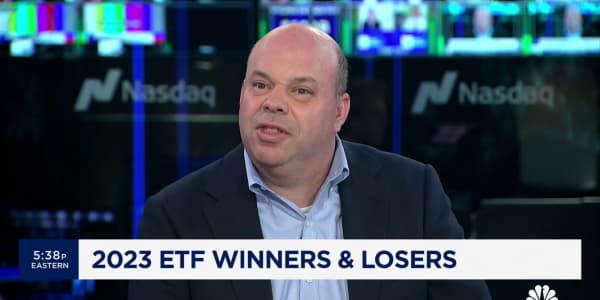The U.S. stock market is on the mend. After getting walloped by two back-to-back corrections in February and March, the S&P 500 has recovered nicely in May, and once again finds itself in positive territory for the year. It's been a wild ride to get here, but the venerable index is up 5 percent from its lowest closing level of the year, and has returned a decent 2.1 percent on a year-to-date basis.
That said, there's more ground to make up before the S&P 500 has completely recovered. From its all-time high of 2,873 set in January, the index is still down 5.6 percent.
Yet while the S&P 500 has more work to do before hitting new highs again, another index is already there. The iShares Russell 2000 ETF (IWM), a $44 billion fund that tracks the Russell 2000 Index, briefly eclipsed its January high on Monday.
The ETF, which holds shares of small U.S. companies, is up 9.5 percent from its lowest closing level of the year and has returned 4.7 percent on a year-to-date basis, easily outpacing the large-cap S&P 500 on both counts.
More from ETF.com:
The next bond crash: An ETF story
Barely any bitcoin left in this booming ETF
Why I don't use target date funds
Analysts say small-caps are outperforming their large-cap counterparts for several reasons. Most of those reasons stem from the fact that small-caps are more focused on the domestic U.S. economy than large-caps.
According to Alec Young, managing director of global markets research for FTSE Russell, small-caps get about 20 percent of their revenues from overseas versus about 35 percent for large-caps.
That more domestic revenue footprint has helped small-caps in a variety of ways, he says, including more exposure to the Republican tax cuts; more exposure to reduced federal regulation; less exposure to geopolitical concerns; and less exposure to trade jitters.
Bull case
Even as small-caps have soundly outpaced their large-cap counterparts, analysts are split as to whether they will continue to outperform.
"When the economy is stronger than normal, small-caps do better," Ryan Detrick, senior market strategist for LPL Financial, told Reuters. "With a good economy like we've seen happening this year, we fully expect this to keep playing out in the second half of the year."
Ari Wald, head of technical analysis at Oppenheimer, agrees with the bullish assessment for small-caps. In his view, the U.S. dollar should continue moving higher from here, making small-caps relatively more attractive compared to large-caps.
The rising dollar "should be a tail wind for small-caps; they have relatively lower multinational sales than large-caps," he told CNBC. "Looking at the relative ratio between the Russell 2000 and the S&P 500, you're seeing small-caps begin to outperform versus the large-caps, in conjunction with that turn in the dollar, and we think that continues. We're especially bullish on small-cap growth," Wald said.
Wald is bullish on small-cap growth stocks, which have done even better than the small-cap group as a whole. He recommends the iShares Russell 2000 Growth ETF (IWO), which is up 6.7 percent this year, and holds nearly half of its portfolio in technology and health care stocks.
Bear case
However, not everyone is convinced the run in small-caps will continue. Eduardo Lecubarri, global head of small- and midcap equity strategy at J.P. Morgan, says small-caps will begin to underperform once the market catches wind of a recession.
"At some point, the market will start to sell [small and midcaps] in anticipation of a recession," he told Bloomberg.
Lori Calvasina, head of U.S. equity strategy at RBC Capital Markets, makes a similar argument against small-caps.
"For well over a year, small has lagged large on the sales beat rate, last seen in 2006-08 before the peak in the bull market," she said. "Small's inability to keep up with large on sales beats helps keep us neutral on small versus large, offsetting other advantages for small, such as flows."
Regardless of where one sees small-caps going from here, it's undeniable they've been hot this year. Out of the entire universe of U.S. small-cap equity ETFs, the vast majority have positive returns so far in 2018. The only laggards are high-dividend and value funds, which have been trounced by their growth counterparts.
See the table below for a list of the top-performing small-cap ETFs of the year.
Top small-cap ETFs in 2018
| Ticker | Fund | YTD Return (%) |
|---|---|---|
| PXSG | PowerShares Russell 2000 Pure Growth Portfolio | 9.63 |
| URTY | ProShares UltraPro Russell2000 | 9.42 |
| SAA | ProShares Ultra SmallCap600 | 9 |
| TNA | Direxion Daily Small Cap Bull 3x Shares | 8.88 |
| JSML | Janus Henderson Small Cap Growth Alpha ETF | 5.98 |
| JKK | iShares Morningstar Small-Cap Growth ETF | 7.74 |
| FYC | First Trust Small Cap Growth AlphaDEX Fund | 7.84 |
| UWM | ProShares Ultra Russell2000 | 7.26 |
| SLYG | SPDR S&P 600 Small Cap Growth ETF | 6.91 |
| VIOG | Vanguard S&P Small-Cap 600 Growth ETF | 6.69 |
Source: ETF.com, data as of May 15
— By Sumit Roy, ETF.com
To get the latest ETF news in your inbox, sign up for ETF.com’s ETF newsletter.




